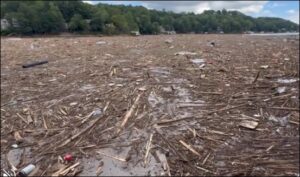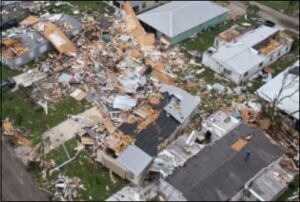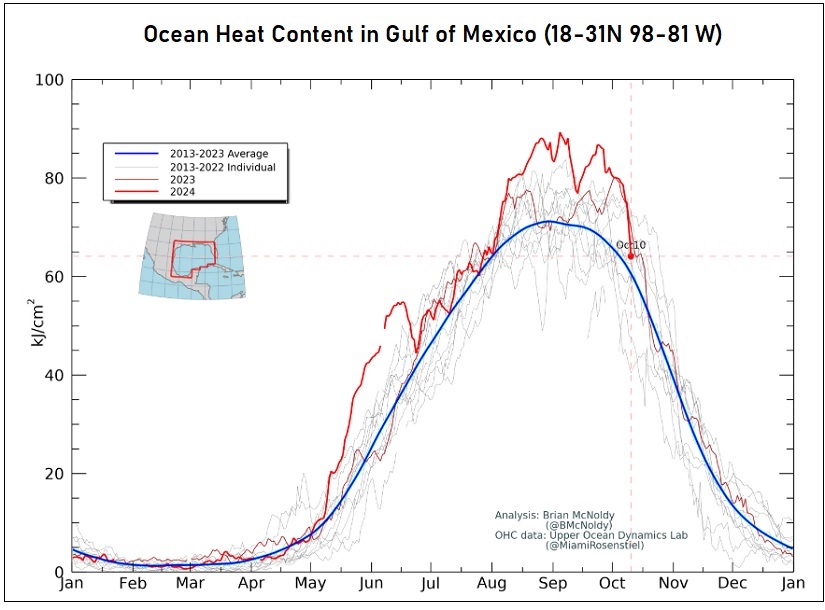By Pam Martens and Russ Martens: October 11, 2024 ~
The size, wind speed intensity, and devastating water impacts of hurricanes originating from the record hot waters of the Gulf of Mexico have sent a wake up call to local and state officials up and down the East Coast of the United States as well as to federal government officials engaged in disaster relief.

Photo Posted on Twitter (X) of What’s Left of Homes in Chimney Rock, North Carolina from Hurricane Helene
Hurricane Helene made landfall on Thursday night, September 26, as a Category 4 hurricane near Perry, Florida. It then proceeded to unleash its wrath northward, plowing through Georgia, South Carolina, North Carolina, and Tennessee. Decimated areas in Western North Carolina – cities and towns such as Asheville, Chimney Rock, Lake Lure, Fairview, Black Mountain and Swannanoa – are 485 miles north of where Hurricane Helene made landfall in Florida.
Unprecedented levels of rainfall from Hurricane Helene turned Western North Carolina rivers into raging torrents of water that “exploded” homes along the rivers and swept them away. Tragically, dozens of people in those homes had no time to escape and died as a result. As of yesterday, the North Carolina Department of Health and Human Services had reported that 91 people had died from Hurricane Helene – representing 40 percent of the total deaths from Hurricane Helene.
The cost to repair roads and bridges, the electrical grid, restore running water and help businesses rebuild in Western North Carolina will be immense. But far worse is the reality that more states and regions will be the next victims of the Gulf of Mexico’s weapons of mass destruction.
What is becoming clear to climate scientists is that the Gulf of Mexico can spin up catastrophic hurricanes in as little as four days and unleash their impacts hundreds of miles away from where they make landfall.
Just 13 days after Hurricane Helene unleashed its fury, Hurricane Milton made landfall along Florida’s Gulf of Mexico coastline at Siesta Key, a barrier island to Sarasota, Florida. According to meteorologists, Hurricane Milton has produced so much rainfall in the Tampa Bay area that it qualifies as a one in 1,000-year rain event.
Although Hurricane Milton made landfall as a Category 3 hurricane, it was one of the most rapidly intensifying hurricanes on record, reaching Category 5 status and 180 mph winds two days before landfall. The National Oceanic and Atmospheric Administration (NOAA) reported the following regarding its rapid intensification:
“Hurricane Milton, the ninth hurricane of the 2024 Atlantic hurricane season, rapidly intensified into a Category 5 storm in the Gulf of Mexico on Monday, October 7, 2024. The storm exploded in strength and intensity at near record pace becoming one of the most intense hurricanes on record in the Atlantic basin. This explosive strengthening was fueled in part by record to near-record warmth across the Gulf of Mexico. The warmer the ocean is, the more fuel there is for hurricanes to intensify, provided other atmospheric conditions (like wind shear) are also favorable.”
Because the public’s awareness of the increasing size and intensity of hurricanes being spun out of the hot waters of the Gulf of Mexico has not kept pace with the fossil fuel industry’s effectiveness in downplaying the impacts of climate change, individual Floridians made dangerous evacuation decisions. (See Mike Johnson, “Champion of the Fossil Fuel Industry” and Climate Change Denier Elected as Speaker of the United States House of Representatives.)
More than 100,000 people on the Gulf Coast (western side) of Florida decided to evacuate to Orlando, Florida, about 131 miles northeast of Sarasota. Old school thinking is that hurricanes lose strength as they travel long distances over land. Unfortunately, that’s far less true of the high-heat charged hurricanes coming from the Gulf of Mexico today.
Hurricane Milton remained a Category 1 hurricane as it charged hundreds of miles across the Florida peninsula, from the west coast to the east coast, eventually exiting into the Atlantic Ocean on the eastern coastline of the state.
Orange County, Florida, home to Orlando, is reporting 97,900 power outages as of 8:46 a.m. EDT this morning. That’s 15 percent of its households. Across Florida, 2.2 million people remain without power this morning.
Hurricane Milton also stunned local emergency management offices by triggering 126 tornado warnings, with 38 tornadoes confirmed thus far. And where did the vast majority of those tornadoes occur? On the opposite side of Florida from where the hurricane made landfall.
An upscale area of Wellington, known as the Equestrian Capital of the World, and located on Florida’s east coast, saw homes battered with intense tornadoes spawned by Hurricane Milton.

Damage from Hurricane Milton-Related Tornado at Spanish Lakes Modular Home Community Near Fort Pierce, FL, October 9, 2024
From Wellington, the tornadoes traveled north to other communities, killing a thus far reported six people in the modular home community of Spanish Lakes Country Club Village in St. Lucie County, near the city of Fort Pierce.


